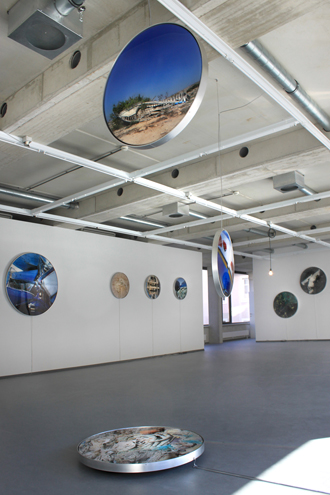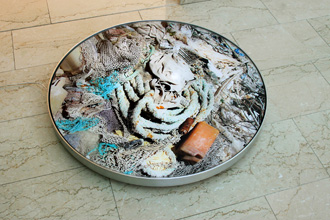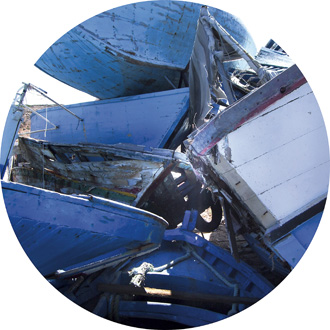DIETER HUBER
MARE MORTO
Mare Morto • Refugees • Stranded
Kerber Verlag, Bielefeld / Leipzig / Berlin,
gebunden / bound, 160 Seiten / pages,
146 Abbildungen / pictures,
deutsch/englisch / German/English
ISBN 978-3-86678-543-4
Euro 37,50
Texte von / texts by Elias Bierdel, European Union, Giorgio Fedeli, Fabio Sanfilippo & Alice Scialoja, Dieter Huber
VANISHING POINTS
Preface
Dieter Huber
Isn't our boat full to the brim already? A refugee project with the resources of visual art? Wouldn't it make more sense to invest the funds required for such a cost intensive project in direct support of migrants and asylum-seekers? What institution or gallery is going to present this joyless theme? What does art have to do with politics? Who wants to surround himself with such images and spend money for them as well?
These were some of the initial reactions to my MARE MORTO project. Most people responded with only hint of a smile or furtive silence. As in the earlier KLONES (manipulation and genetic engineering), PLEASURE FILES (aspects of subjective pleasure) and AIRBORN (social change and individual shifts) series, I am attempting in this case to go the sphere of personal attraction and enthusiasm in order to address - in art - issues I regard as both socially relevant and underrepresented. Quite often these works generate no response and are not exhibited or sold in the art market -thus making the next project possible - until some years have passed.
I have been collecting evidence of attempted flights to refuge on islands off the southern coast of Italy for years. The product of these efforts is this series consisting of three sets of 33 images each. The dominant visual motif is the metaphor of the boat. MARE MORTO features destroyed refugee boats. REFUGEES gathers together individual items of evidence - “corpora delicti of flight” to the fortress of Europe - and STRANDED shows “recycled” ships that offer hope of a new beginning.
Two aspects are implied in the title MARE MORTO: the hundreds of sunken refugee boats and countless corpses in the southern Mediterranean and the bay with the calm sea. The latter lies before one on the few accessible rocky coastlines on eastern Lampedusa that have not (yet) been completely destroyed by rogue construction and cheap tourism.
The circular painting (tondo), which is actually an antiquated form of a picture without clearly defined boundaries, is the most appropriate formal means of expression in this context. It allows the gaze to expand rather than squeezing it into a square. While we are accustomed to the latter form, it does not correspond to our oval - rounder - field of vision. Formal affinities with the circular painting are found in the porthole, through which one views the setting of a supposed future, and in the telescope, with which we take a closer look at interesting and significant places and things. Regardless of the timeless quality of the subject of flight, this book appears at the just right moment in the midst of political and social upheavals in North Africa. The events unfolding at this very moment put our European values, which we regard as universally valid and of which we are rightly proud, to the test. The death of thousands of nameless boat refugees in the southern Mediterranean is a fact that draws scant media coverage. We want to know as little as possible about such things - presumably because we suspect that such knowledge could disturb, and perhaps even change our comfortable lives. The silence of the political community and the media is an outrage; our own silence is a disgrace! Aren't we all refugees? Those from the north who have sought the sun, culture and la dolce vita since long before the Romantic age? Those from the south who arrive by plane as “Overborder” or crash with their boats against the wall of Europe? That is a questionable comparison with incomparable roots, yet all of us construct vanishing points that make our everyday lives easier or perhaps possible at all - fantasies that precede reality and can only be realized as such; longings, projected in people or localized in landscapes, systems, climate zones, political structures or realms of the mind. What can one do when law and human rights collide, when national or European policy strips people of their fundamental rights and implicitly designates them as refuse? Who has the right to establish such definitions?
We, as citizens of the EU, must define our own personal boundaries, the points at which we cease to collaborate and are compelled to take a stand. That point is reached at the latest when politicians and bureaucrats stamp us as criminals for wanting to help and enact law prohibiting us from coming to the aid of people whose lives are in acute danger. Such foundations of social life as justice were fought for long ago. They are anchored in law and regarded as self-evident today. Yet we also accept the fact that many of these fundamental rights are ignored and diminished - in cases like the payment of lower wages for women who perform the same work as men. There must be room in our culture for recognition of these dissonances and efforts to rectify them. And that has nothing to do with so-called “radical humanism.” When public awareness of our European values wanes and we cease to defend them, we will simply lose them entirely.
We are not all in the same boat, of course. Apart from satisfying our existential needs and comforts, all that really counts is the answer to a question we must all ask ourselves sooner or later: What can I truly offer in life, and what is my own personal contribution? |
|
 download 300 dpi COLOR download 300 dpi COLOR
download 300 dpi SW
 download 300 dpi COLOR download 300 dpi COLOR
download 300 dpi SW
 download 300 dpi COLOR download 300 dpi COLOR
download 300 dpi SW
|
|
FLUCHTPUNKTE
Vorwort
Dieter Huber
Ist unser Boot nicht längst voll? Ein Flüchtlingsprojekt mit den Mitteln der bildenden Kunst? Wären die finanziellen Mittel eines solch aufwendigen Projekts nicht in der direkten Unterstützung von Asylanten und Migranten in Not sinnvoller angelegt? Welche Institution oder Galerie soll diese unerfreuliche Thematik zeigen? Was soll Kunst mit Politik zu tun haben? Wer will sich mit solchen Bildern umgeben und dafür Geld ausgeben?
Dies waren die Reaktionen auf mein Projekt MARE MORTO. Meist war es auch nur ein mildes Lächeln oder verstohlenes Schweigen. Wie schon bei den Serien KLONES (Manipulation und Gentechnik), PLEASURE FILES (Fragen zur subjektiven Freude) oder AIRBORN (soziale Veränderungen und individueller Ebenenwechsel), versuche ich über die persönliche Attraktion und Begeisterung hinaus, in der Kunst Inhalte zu thematisieren, die ich für gesellschaftlich relevant und zugleich unterrepräsentiert halte. Nicht selten finden diese Arbeiten oft erst Jahre nach dem Entstehen ihre Resonanz, werden am Kunstmarkt gezeigt und gekauft und ermöglichen somit das nächste Vorhaben.
Über Jahre hinweg habe ich auf süditalienischen Inseln Spuren der Flucht gesammelt. Daraus ist dieser 3 Mal 33 Bilder umfassende Bilderzyklus entstanden. Tragendes Bildmotiv ist die Metapher des Bootes. MARE MORTO zeigt zerstörte Flüchtlingsboote, REFUGEES sammelt individuelle Beweisstücke – „Corpora Delicti der Flucht“ in die Festung Europa – und STRANDED zeigt Schiffe „recycled“, die auf einen Neubeginn hoffen lassen.
Der Titel MARE MORTO impliziert zweierlei: die hunderte versunkenen Flüchtlingsboote und unzählige Leichen im südlichen Mittelmeer sowie die Bucht mit dem ruhigen Meer. Diese liegt an einer der wenigen zugänglichen Felsküsten im Osten der Insel Lampedusa, die (noch) nicht komplett von Schwarzbauten und Billigtourismus zerstört wurden.
Das Rundbild (Tondo), eigentlich die antiquierte Form für ein Bild ohne klare Begrenzung, ist hier die adäquate formale Umsetzung. Dadurch ist der Blick offen und nicht in ein Viereck gequetscht. Letzteres sind wir zwar gewohnt, entspricht aber nicht unserem ovalen, also viel eher rundem, Gesichtsfeld. Formale Entsprechung findet das Rundbild im Bullauge, durch das auf den Ort der vermeintlichen Zukunft geschaut wird, oder auch im Fernglas, mit dem wir Interessantes und Bedeutsames näher ins Auge fassen können. Abgesehen von der Überzeitlichkeit des Themas Flucht, erscheint dieses Buch gerade im richtigen Augenblick, parallel zu den radikalen politischen und sozialen Veränderungen in Nordafrika. Das aktuelle Zeitgeschehen stellt unsere europäischen Werte, denen wir Weltgeltung beimessen und auf die wir mit Recht stolz sein können, auf den Prüfstand. Der Tod Tausender anonymer Bootsflüchtlinge pro Jahr im südlichen Mittelmeer ist ein Faktum, das medial nur gestreift wird. Wir wollen davon so wenig wie möglich wissen. Wohl auch, weil wir ahnen: Dies könnte unser angenehmes Lebens empfindlich beeinträchtigen, gar verändern. Das politische und mediale Stillhalten ist empörend, unser Schweigen eine Schande!
Sind wir nicht alle Flüchtlinge? Die aus dem Norden, die nicht erst seit der Romantik Sonne, Kultur und Dolce Vita suchen? Die aus dem Süden, die per Flugzeug als „Overborder“ einreisen oder mit dem Boot am Wall Europas zerschellen? Natürlich ein illegitimer Vergleich mit unvergleichbaren Wurzeln und dennoch: Wir alle konstruieren Fluchtpunkte, die unseren Alltag erleichtern oder gar erst ermöglichen. Fantasien, die der Realität vorausgehen und so erst materialisiert werden können. Sehnsüchte, projiziert in Menschen, oder verortet in Landschaften, Systemen, Klimazonen, politischen Gebilden, geistigen Zonen.
Was tun, wenn Gesetz und Recht kollidieren? Wenn durch nationale oder europäische Politik Menschen alle Grundrechte abgesprochen und sie indirekt zu Müll erklärt werden? Wem steht so ein Definitionsrecht zu?
Wir EU-Bürger müssen selbst über unsere persönliche Grenze entscheiden, ab der kein Mitspielen mehr möglich ist und Haltung unabdingbar wird. Spätestens dann, wenn uns Politiker und Bürokraten fürs Helfen kriminalisieren, per Gesetz untersagen wollen, Menschen aus akuter Lebensgefahr zu retten. Gesellschaftliche Grundlagen wie Gerechtigkeit wurden erkämpft, gesetzlich verankert und scheinen uns heute selbstverständlich. Zugleich akzeptieren wir, dass viele dieser Grundrechte ignoriert und beschnitten werden, wie etwa ungleicher Lohn für Frauen für gleiche Arbeit – sich dieser Dissonanzen bewusst zu werden und dagegen anzutreten, muss Platz haben in unserer Kultur und hat noch lange nichts mit einem „radikalen Humanismus“ zu tun. Wenn das breite Bewusstsein für unsere Europäischen Werte schwindet und wir sie nicht verteidigen, werden wir sie einfach verlieren.
Natürlich sitzen wir nicht alle im gleichen Boot. Jenseits der Befriedigung unserer existenziellen Bedürfnisse und Behaglichkeiten zählt letztlich nur die Antwort auf eine Frage, der wir uns früher oder später alle stellen müssen: Was kann ich im Leben wirklich bieten und wie sieht mein persönlicher Beitrag aus? |